Over the last few years, new and exotic foods have been appearing at my local grocery. Only one or two have jumped spontaneously into my shopping basket. Others have whispered and cajoled, “Try me, try me!” Those prompts, a generally adventurous palate, and a need to make changes in my diet, lead me to several new-to-me foods. Not all foods have been a success—-I do not have the cilantro gene, the parsley pretender tastes like soap to me.
Even so, I thought I might try the cute, small, firm, oversized gooseberries. The produce clerk was quick to let me know that those green fruits “are not green tomatoes.”
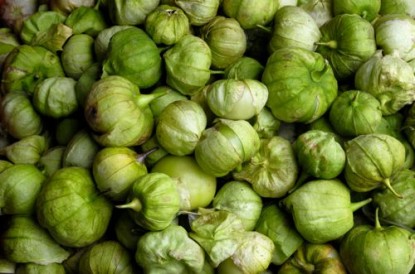
“What are they, what do they taste like?”
“Tomatillos (toe-ma-tee-ohs). They’re not like green tomatoes.”
I turned to the Internet, and found the same negative description. Time to do more research.
The tomatillo (Physalis philadelphica) is a member of the nightshade family, related to the cape gooseberry and the (regular) tomato. The fruit is small, spherical, and green or green-purple and ranges in size from about an inch in diameter to the size of an apricot. Tomatillos’ distinguishing characteristic is a papery husk covering which occurs in shades of pale green to a light grocery-bag brown.
Other English names for the fruit include husktomato, jamberry, and ground cherry. Their Spanish name is “tomate verde” (which means green tomato) and are considered a staple in Mexican and Guatemalan cooking. Tomatillos have a very tart flavor, not at all like a tomato. Ahha! A flavor hint, they’re tart!
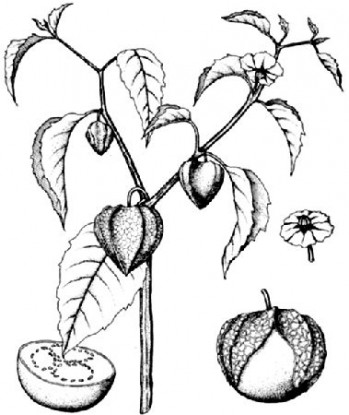
Neglected Crops: 1492 from a Different Perspective. J.E. Hernándo Bermejo and J. León (eds.). 1994. Food and Agriculture Organization of the United Nations.
The fruit dates back to at least 800 B.C.E. The Aztecs—whose word for the fruit, tomatl means something “round and plump”–domesticated the tomatillo. Europeans who tried to document New World foods confused the Aztec word for tomato xitomatl with miltomatl, the word for tomatillo. Europeans frequently shortened both names to tomatl, accounting for even more confusion. The fruit now grows everywhere in the Western Hemisphere and is common in Texas gardens.
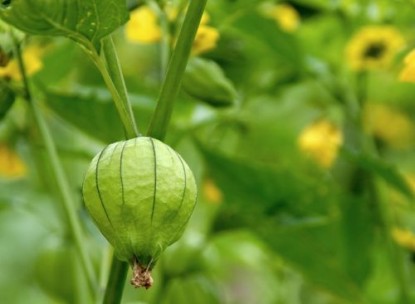
Tomatillos are the key ingredient in fresh and cooked Latin American green sauces (salsa verde). Fresh tomatillos are available in chain grocery stores as well as in Hispanic markets.
Introduction to preparing tomatillos:
- Select unblemished fruit that completely fill the papery outer husk. The husk itself should be light brown and fresh looking, neither shriveled nor dried). A firm and still green fruit will still have its tart flavor. A tomatillo beginning to turn a light yellow is ripe and past its prime for most uses.
- Tomatillos can keep in the refrigerator for about two weeks. Some sources claim tomatillos will keep even longer if the husks are removed. Loosely wrap fruit in paper and store in a single layer or place in paper bag. Store in the coolest region of the refrigerator. Home-grown tomatillos are ready to harvest when the husks burst. Pull up the entire plant and store in a cool, dark, dry area and remove fruit as needed.
- To use tomatillos, remove and discard the papery husks, rinse, dry, and proceed according to your recipe. Tomatillos are generally not seeded prior to use. Their texture is firm when raw, but soft when cooked.
- Tomatillos freeze well. Remove the papery husks, clean, and place in freezer-weight self-sealing bags. When you want to use them, remove as many as you like and thaw. Tomatillos can also be cleaned, sliced, and then frozen. However, this exposes more fruit surface to the air, and there will be more vitamin loss as well as potential flavor loss.
- 1 pound fresh tomatillos = one (11-ounce) can of tomatillos.
- Raw or uncooked tomatillos are often included in Mexican sauces where they add a fresh citrus-like flavor. Blanching mellows the flavor. Place whole tomatillos (husks removed and fruit rinsed) in boiling water. Boil for approximately five minutes or until soft. Drain and crush, or puree, as directed by recipe.
- Tomatillos can be fire roasted under the broiler, with a propane torch, or over an open flame such as a grill. Make sure the heat source is quite hot; a too-cool fire will turn the tomatillos to mush before they char. Charred or slightly blackened skins will enrich your sauce with a smoky flavor.
- Dry roasting produces an earthy, nutty flavor. Place the tomatillos in a heavy, preferably cast iron, fry pan. Place over low heat and roast for approximately 20 to 30 minutes, turning occasionally.
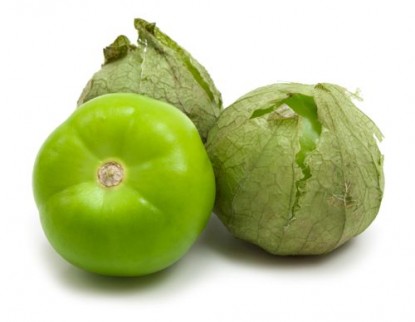
credit: ©iStockphoto.com/Creativeye99
Lots of information about tomatillos, but I still don’t know what a tomatillo tastes like. I don’t want to try a recipe for a salsa verde—that would involve too many additional ingredients. What if I didn’t like the tomatillo’s taste? Would I be able to salvage the recipe?
Then I found a trial recipe with only three ingredients: tomatillos, sugar, and lime. Just the ticket.
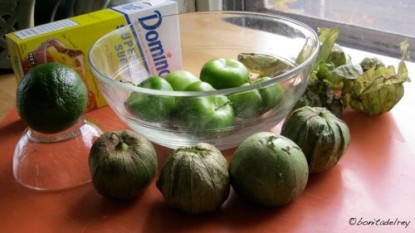
How to make TOMATILLO AND LIME JAM: Printable
Mermelada de Tomate Verde con Limón
Select 1 pound unripe tomatillos. Remove husks, rinse, and rough chop fruit.
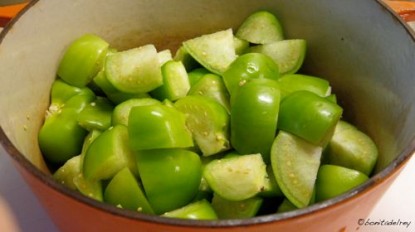
Remove the peel from one lime. Cut peel into very thin strips. Juice lime, capturing 4 tablespoons fresh juice.
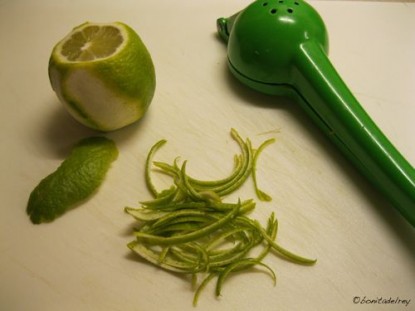
Add rind, lime juice, 1 1/2 cups sugar, and pinch of salt to tomatillos. Pour in 1 cup water, stir. Set saucepan over medium-high heat. Let mixture come to a simmer, stirring occasionally.
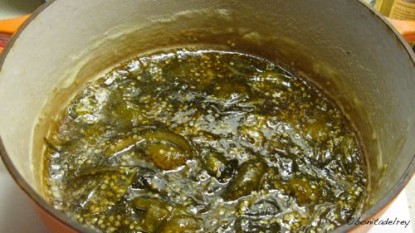
Cook until mixture thickens and forms a soft jam consistency.
Ladle jam into hot, sterilized jars. Makes about 1 1/2 cups jam.
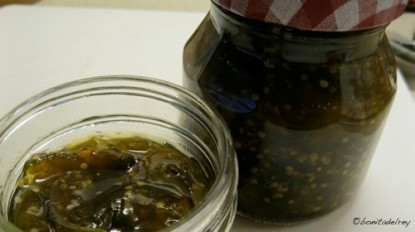
The jam is delicious. Dare I say it tastes a bit like green tomato jam? It’s great paired with apples, pears, and cheese, particularly cheddar cheese. It was a simple and inexpensive way to experience the taste of the humble tomatillo. This tomatillo and lime jam will make an unusual addition to your holiday appetizer selection, a bright jam for toast on a holiday morning, and a simple last-minute gift. Not to shabby for a “not-green-tomato!”
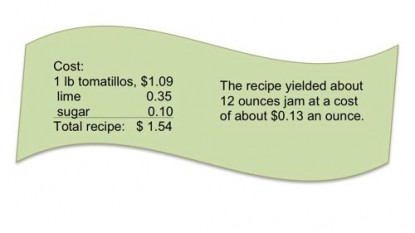
Do you have a recipe post or kitchen-related story to share on the Farm Bell blog?
See Farm Bell Blog Submissions for information, the latest blog contributor giveaway, and to submit a post.Want to subscribe to the Farm Bell blog? Go here.




Praiz says:
I LOVE Salsa Verde and plan to plant tomatillos next year. Love the idea of using them in jam…..may have to try this. Thanks for sharing all the info and the recipe.
On November 27, 2011 at 10:38 am
JerseyMom says:
Me too, me too!! LOVE salsa verde, enchiladas verde…any of those verdes! Part of my childhood was spent in the southwestern US so that makes sense. Give me TexMex any day and I will thank you. My dh grows tomatillos and they are mostly volunteers now. I’ll have to give the jam a whirl too. It sounds yummy. Thanks for sharing!
On November 27, 2011 at 5:51 pm